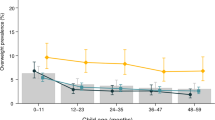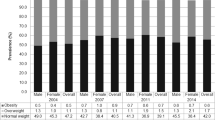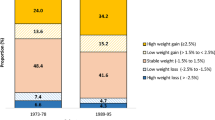Abstract
Objective:
There has been an increase in overweight among women in low- and middle-income countries but whether these trends differ for women in different occupations is unknown. We examined trends by occupational class among women from 33 low- and middle-income countries in four regions.
Design:
Cross-national study with repeated cross-sectional demographic health surveys.
Subjects:
Height and weight were assessed at least twice between 1992 and 2009 in 248 925 women aged 25–49 years. Interviews were conducted to assess occupational class, age, place of residence, educational level, household wealth index, parity, age at first birth and breastfeeding. We used logistic and linear regression analyses to assess the annual percent change in overweight (body mass index >25 kg m−2) by occupational class.
Results:
The prevalence of overweight ranged from 2.2% in Nepal in 1992–1997 to 75% in Egypt in 2004–2009. In all the four regions, women working in agriculture had consistently lower prevalence of overweight, while women from professional, technical, managerial as well as clerical occupational classes had higher prevalence. Although the prevalence of overweight increased in all the occupational classes in most regions, women working in agriculture and production experienced the largest increase in overweight over the study period, while women in higher occupational classes experienced smaller increases. To illustrate, overweight increased annually by 0.5% in Latin America and the Caribbean and by 0.7% in Sub-Saharan Africa among women from professional, technical and managerial classes, as compared with 2.8% and 3.7%, respectively, among women in agriculture.
Conclusion:
The prevalence of overweight has increased in most low- and middle-income countries, but women working in agriculture and production have experienced larger increases than women in higher occupational classes.
This is a preview of subscription content, access via your institution
Access options
Subscribe to this journal
Receive 12 print issues and online access
$259.00 per year
only $21.58 per issue
Buy this article
- Purchase on Springer Link
- Instant access to full article PDF
Prices may be subject to local taxes which are calculated during checkout



Similar content being viewed by others
References
WHO. Global Status Report on Noncommunicable Diseases 2010. World Health Organization: Geneva, Switzerland, 2011.
WHO. Global Health Risks. Mortality and Burden of Disease Attributable to Selected Mmajor Risks. World Health Organization: Geneva, Switzerland, 2009.
Finucane MM, Stevens GA, Cowan MJ, Danaei G, Lin JK, Paciorek CJ et al. National, regional, and global trends in body-mass index since 1980: systematic analysis of health examination surveys and epidemiological studies with 960 country-years and 9.1 million participants. Lancet 2011; 377: 557–567.
Popkin BM, Adair LS, Ng SW . Global nutrition transition and the pandemic of obesity in developing countries. Nutr Rev 2012; 70: 3–21.
Mendez MA, Monteiro CA, Popkin BM . Overweight exceeds underweight among women in most developing countries. Am J Clin Nutr 2005; 81: 714–721.
Razak F, Corsi DJ, Sv S . Change in the body mass index distribution for women: analysis of surveys from 37 low- and middle-income countries. PLoS Med 2013; 10: e1001367.
Balarajan Y, Villamor E . Nationally representative surveys show recent increases in the prevalence of overweight and obesity among women of reproductive age in Bangladesh, Nepal, and India. J Nutr 2009; 139: 2139–2144.
Filozof C, Gonzalez C, Sereday M, Mazza C, Braguinsky J . Obesity prevalence and trends in Latin-American countries. Obes Rev 2001; 2: 99–106.
Dodzin S, Vamvakidis A . Trade and industrialization in developing economies. J Dev Econ 2004; 75: 319–328.
Popkin BM . The nutrition transition and obesity in the developing world. J Nutr 2001; 131: 871S–873S.
Treiman DJ . Industrialization and social stratification. Sociol Inq 1970; 40: 207–234.
UN. Completing the fertility transition. United Nation Popul Bull 2009; 48/49: 1–507.
Cáceres-Delpiano J . Can we still learn something from the relationship between fertility and mother’s employment? Evidence from developing countries. Demography 2012; 49: 151–174.
ILO. Global Employment Trends 2012. Preventing a Deeper Job Crisis. International Labour Office: Geneva, Switzerland, 2012.
FAO. The State of Food and Agriculture. Women in Agriculture. Closing the Gender Gap for Development. Food and Agriculture Organization of the United Nations: Rome, Italy, 2011.
Bauman A, Ma G, Cuevas F, Omar Z, Waqanivalu T, Phongsavan P et al. Cross-national comparisons of socioeconomic differences in the prevalence of leisure-time and occupational physical activity, and active commuting in six Asia-Pacific countries. J Epidemiol Community Health 2011; 65: 35–43.
Allman-Farinelli MA, Chey T, Merom D, Bauman AE . Occupational risk of overweight and obesity: an analysis of the Australian Health Survey. J Occup Med Toxicol 2010; 5: 14–23.
Galobardes B, Morabia A, Bernstein MS . The differential effect of education and occupation on body mass and overweight in a sample of working people of the general population. Ann Epidemiol 2000; 10: 532–537.
Church TS, Thomas DM, Tudor-Locke C, Katzmarzyk PT, Earnest CP, Rodarte RQ et al. Trends over 5 decades in U.S. occupation-related physical activity and their associations with obesity. PLoS One 2011; 6: 1–7.
Pigeyre M, Dauchet L, Simon C, Bongard V, Bingham A, Arveiler D et al. Effects of occupational and educational changes on obesity trends in France: the results of the MONICA-France survey 1986–2006. Prev Med 2011; 52: 305–309.
Gregory CO, Dai J, Ramirez-Zea M, Stein AD . Occupation is more important than rural or urban residence in explaining the prevalence of metabolic and cardiovascular disease risk in Guatemalan adults. J Nutr 2007; 137: 1314–1319.
Sarkar A, Aronson KJ, Patil S, Hugar LB, vanLoon GW . Emerging health risks associated with modern agriculture practices: a comprehensive study in India. Environ Res 2012; 115: 37–50.
Rutstein SO, Rojas G . Guide to DHS Statistics. ORC Macro: Calverton, MD, USA, 2006.
ICF I. Survey Organization Manual for Demographic and Health Surveys. ICF International: Calverton. MD, USA, 2012.
World Bank. World Trade Indicators (July 2009–July 2010). accessed at http://data.worldbank.org/about/country-classifications in 2012.
ORC M. Intervieweŕs Manual for Use with Model "A" Questionnaire for High Contraceptive Prevalence Countries. ORC Macro: Calverton, MD, USA, 2002.
WHO. Physical Status: The Use and Interpretation of Anthropometry. World Health Organization: Geneva, Switzerland, 1995.
Neuman M, Finlay JE, Davey Smith G, Subramanian SV . The poor stay thinner: stable socioeconomic gradients in BMI among women in lower- and middle-income countries. Am J Clin Nutr 2011; 94: 1348–1357.
ILO. International Standard Classification of Occupations (ISCO- 88) International Labor Organization. Geneva, Switzerland, 1990.
Rutstein SO, Johnson K . The DHS Wealth Index. ORC Macro: Calverton, MD, USA, 2004.
Zou GA . Modified Poisson regression approach to prospective studies with binary data. Am J Epidemiol 2004; 159: 702–706.
Keighley ED, McGarvey ST, Turituri P, Viali S . Farming and adiposity in Samoan adults. Am J Human Biol 2006; 18: 112–122.
Levine JA, McCrady SK, Boyne S, Smith J, Cargill K, Forrester T . Non-exercise physical activity in agricultural and urban people. Urban Stud 2011; 48: 2417–2427.
Bockerman P, Johansson E, Jousilahti P, Uutela A . The physical strenuousness of work is slightly associated with an upward trend in the BMI. Soc Sci Med 2008; 66: 1346–1355.
Choi B, Schnall PL, Yang H, Dobson M, Landsbergis P, Israel L et al. Sedentary work, low physical job demand, and obesity in US workers. Am J Ind Med 2010; 53: 1088–1101.
Huneault L, Mathieu MÈ, Tremblay A . Globalization and modernization: an obesogenic combination. Obes Rev 2011; 12: e64–e72.
Mishra CP . Nexus of poverty, energy balance and health. Indian J Community Med 2012; 37: 71–78.
Brun TA, Geissler CA, Mirbagheri I, Hormozdiary H, Bastani J, Hedayat H . The energy expenditure of Iranian agricultural workers. Am J Clin Nutr 1979; 32: 2154–2161.
Steele R, Mummery K . Occupational physical activity across occupational categories. J Sci Med Sport 2003; 6: 398–407.
Monda KL, Gordon-Larsen P, Stevens J, Popkin BM . China's transition: The effect of rapid urbanization on adult occupational physical activity. Soc Sci Med 2007; 64: 858–870.
Ng SW, Norton EC, Popkin BM . Why have physical activity levels declined among Chinese adults? Findings from the 1991–2006 China health and nutrition surveys. Soc Sci Med 2009; 68: 1305–1314.
Hawkes C, Ruel M . The links between agriculture and health: an intersectoral opportunity to improve the health and livelihoods of the poor. Bull World Health Organ 2006; 84: 984–990.
Mehio Sibai A, Nasreddine L, Mokdad AH, Adra N, Tabet M, Hwalla N . Nutrition transition and cardiovascular disease risk factors in Middle East and North Africa countries: reviewing the evidence. Ann Nutr Metab 2010; 57: 193–203.
Rutstein SO, Shah IH . Infecundity, Infertility, and Childlessness in Developing Countries. ORC Macro and the World Health Organization: Calverton, MD, USA, 2004.
Pan WH, Flegal KM, Chang HY, Yeh WT, Yeh CJ, Lee WC . Body mass index and obesity-related metabolic disorders in Taiwanese and US whites and blacks: implications for definitions of overweight and obesity for Asians. Am J Clin Nutr 2004; 79: 31–39.
Rush EC, Freitas I, Plank LD . Body size, body composition and fat distribution: comparative analysis of European, Maori, Pacific Island and Asian Indian adults. Br J Nutr 2009; 102: 632–641.
Wen CPD, Cheng TY, Tsai SP, Chan HT, Hsu HL, Hsu CC et al. Are Asians at greater mortality risks for being overweight than Caucasians? Redefining obesity for Asians. Public Health Nutr 2009; 12: 497–506.
EC. WHO . Appropiate body-mass index for Asian populations and its implications for policy and intervention strategies. Lancet 2004; 363: 157–163.
Low S, Chin MC, Ma S, Heng D, Deurenberg-Yap M . Rationale for redefining obesity in Asians. Ann Acad Med Singapore 2009; 38: 66–69.
Acknowledgements
SL-A was supported by the European Union Erasmus Mundus Partnerships program Erasmus-Columbus (ERACOL) at Erasmus MC in the Netherlands. MA was supported by a Starting Researcher grant from the European Research Council (ERC; (Grant No 263684), a fellowship from Erasmus University Rotterdam and a grant from the National Institute of Ageing (R01AG037398).
Author information
Authors and Affiliations
Corresponding author
Ethics declarations
Competing interests
The authors declare no conflict of interest.
Additional information
Supplementary Information accompanies this paper on International Journal of Obesity website
Supplementary information
Rights and permissions
About this article
Cite this article
Lopez-Arana, S., Avendano, M., van Lenthe, F. et al. Trends in overweight among women differ by occupational class: results from 33 low- and middle-income countries in the period 1992–2009. Int J Obes 38, 97–105 (2014). https://doi.org/10.1038/ijo.2013.50
Received:
Revised:
Accepted:
Published:
Issue Date:
DOI: https://doi.org/10.1038/ijo.2013.50
Keywords
This article is cited by
-
The weight of work: the association between maternal employment and overweight in low- and middle-income countries
International Journal of Behavioral Nutrition and Physical Activity (2017)
-
The prevalence of excessive weight in Balearic Islands’ young and middle-aged women and its association with social and socioeconomic factors: a ten-year trend (2000–2010)
BMC Public Health (2015)
-
Associations Between Orphan and Vulnerable Child Caregiving, Household Wealth Disparities, and Women’s Overweight Status in Three Southern African Countries Participating in Demographic Health Surveys
Maternal and Child Health Journal (2015)



